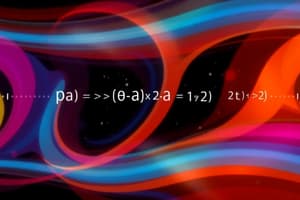Podcast
Questions and Answers
What is the foundation of dynamic programming?
What is the foundation of dynamic programming?
Solving each problem instance using previously computed results
When is dynamic programming particularly useful?
When is dynamic programming particularly useful?
When encountering problems with optimal substructure properties
Define overlapping subproblems in the context of dynamic programming.
Define overlapping subproblems in the context of dynamic programming.
Existence of identical substructures that, when solved optimally once, give solutions for multiple instances of the original problem
Name some common application areas where dynamic programming is effective.
Name some common application areas where dynamic programming is effective.
What are the fundamental concepts underlying dynamic programming?
What are the fundamental concepts underlying dynamic programming?
What is the Optimal Substructure Property in dynamic programming?
What is the Optimal Substructure Property in dynamic programming?
How does Memoization help in dynamic programming?
How does Memoization help in dynamic programming?
What is the difference between Backtracking and Memoized Backtracking in dynamic programming?
What is the difference between Backtracking and Memoized Backtracking in dynamic programming?
Explain how dynamic programming is applied to solve the Fibonacci numbers problem.
Explain how dynamic programming is applied to solve the Fibonacci numbers problem.
What is the Edit Distance problem in dynamic programming, and how does dynamic programming approach it?
What is the Edit Distance problem in dynamic programming, and how does dynamic programming approach it?
Flashcards are hidden until you start studying
Study Notes
Analysis and Design of Algorithms: Dynamic Programming Explored
Dynamic programming is a powerful technique used to solve complex problems by breaking them down into smaller, overlapping subproblems. It's particularly useful when you encounter problems with optimal substructure properties – meaning their solutions can be derived from combining optimal solutions to its subproblems. In this article, we'll dive deeper into dynamic programming's principles, applications, and the analysis techniques applied during algorithm development.
Overview
The foundation of dynamic programming lies in solving each problem instance using previously computed results rather than recomputing them every time they're needed. This approach utilizes memoization and overlapping subproblem optimization, resulting in more efficient computation times.
Applications
Some common application areas where dynamic programming shines include:
- Knapsack Problems
- Longest Common Subsequence (LCS)
- Optimal Binary Search Trees
- Shortest Path Calculations via Dijkstra’s Algorithm
Fundamentals
Before jumping into specific examples, let's review some fundamental concepts underlying dynamic programming:
-
Overlapping Subproblems: These exist whenever there exists a problem having several identical substructures which, when solved optimally once, give rise to solutions for multiple instances of the original problem.
-
Optimal Substructure Property: If a solution consists of optimal subproblems, it must itself also be optimal. For example, if one path to reach destination X contains only shorter paths, it will result in the shortest overall distance.
-
Memoization: Storing computational results so that repeated calculations aren't performed unnecessarily. This principle saves significant computation time.
-
Backtracking vs. Memoized Backtracking: Backtracking represents a recursive process where duplicating work may occur; however, using memoization prevents this redundancy, improving efficiency.
Examples
To illustrate how these principles apply, consider two famous dynamic programming problems: Fibonacci numbers and Edit Distance.
Fibonacci Numbers
Fibonacci numbers arise sequentially according to the rule F(n) = F(n - 1) + F(n - 2), starting from base cases F(1) = F(2) = 1. DP solves this problem by storing previously calculated values instead of recalculating them repeatedly.
def fibonacci_dp(n):
dp = * (n+1)
dp, dp = 1, 1
# Compute F(n) using DP
for i in range(3, n+1):
dp[i] = dp[i-1] + dp[i-2]
return dp[-1]
This code snippet demonstrates a simple example of creating a function utilizing dynamic programming to calculate Fibonacci numbers efficiently, avoiding exponential complexity.
Edit Distance
Another fascinating example is computing the minimal number of edits required to transform one string to another—editing operations typically including insertions, deletions, and substitutions. A naïve implementation would require O(m x n) space complexity. However, dynamic programming reduces this to O(min(m, n)) space complexity:
def edit_distance(str1, str2):
m, n = len(str1)+1, len(str2)+1
dp = [*(n) for _ in range(m)]
for j in range(n):
dp[j] = j
for i in range(m):
dp[i] = i
for i in range(1, m):
for j in range(1, n):
if str1[i-1] == str2[j-1]:
dp[i][j] = dp[i-1][j-1]
else:
insertion = dp[i][j-1]+1
deletion = dp[i-1][j]+1
replacement = dp[i-1][j-1]+((str1[i-1] != str2[j-1]) and 1 or 0)
dp[i][j] = min(insertion, deletion, replacement)
return dp[-1][-1]
Here's our Python implementation of calculating the minimum cost of converting one string to another using dynamic programming.
Conclusion
In conclusion, dynamic programming offers a highly effective methodology when dealing with challenging algorithmic questions characterized by overlapping subproblems, allowing us to exploit previously calculated data to make subsequent calculations more straightforward and less expensive. While understanding the foundations of dynamic programming may take some effort initially, mastery yields substantial rewards in terms of improved performance and the ability to tackle intricate issues across various domains.
Studying That Suits You
Use AI to generate personalized quizzes and flashcards to suit your learning preferences.



